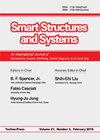基于可观测列车模型的响应型轨道轮廓估计,并进行了数值和实验验证
IF 2.2
3区 工程技术
Q2 ENGINEERING, CIVIL
引用次数: 0
摘要
铁路轨道状态监测是保障铁路运行安全的重要手段。轨道轮廓线是列车系统外部激励的主要来源。虽然轨道记录车经常用于维护目的,但这种特殊的车辆价格昂贵,难以用于小型铁路运营商。因此,研究了通过在役车辆响应测量来估计轨道轮廓的方法,该方法可能提供高效和频繁的测量。然而,由于反分析结果有时不准确甚至不稳定,对垂直和横向轨道轮廓的定量评价仍然具有挑战性。本文首先对列车车体加速度和角速度响应进行了数值分析。在逆分析中,利用增广状态卡尔曼滤波器求解4自由度可观测列车模型。通过可观测秩条件分析,对不同测量布局下传感器的安装位置进行了研究。其次,在日本当地运营的铁路网中进行了现场试验,从车体运动中估计轨道轮廓。智能手机作为流行的传感设备用于现场测试测量。通过可观测列车模型验证了该方法的有效性。数值分析和现场实验验证了所提出的轨迹轮廓估计方法本文章由计算机程序翻译,如有差异,请以英文原文为准。
Response based track profile estimation using observable train models with numerical and experimental validations
Condition monitoring of railway tracks is essential in guaranteeing the running safety of railways. Track profiles are the primary source of external excitation for a train system. While Track Recording Vehicle is often utilized for maintenance purposes, this particular vehicle is expensive and difficult to use for small railway operators. Therefore, track profile estimation through in-service vehicle response measurements, which potentially provides efficient and frequent measurement, has been studied. However, the quantitative evaluation of the vertical and lateral track profile irregularities is still challenging as the inverse analysis solutions are sometimes inaccurate and even unstable. In this paper, numerical analyses are first carried out to evaluate track profiles from acceleration and angular velocity responses measured on a train car body. For the inverse analysis, an Augmented State Kalman Filter is utilized to solve the problem using 4 degrees of freedom observable train models. The sensor installation locations are investigated through observability rank condition analysis with different measurement layout. Secondly, a field experiment is carried out in a local Japanese in-service railway network to estimate track profile from car body motions. Smartphones are utilized for the field test measurements as prevalent sensing devices. The effectiveness of the proposed approach is demonstrated with the observable train model. Numerical analyses and field experiments clarify the proposed track profile estimation
求助全文
通过发布文献求助,成功后即可免费获取论文全文。
去求助
来源期刊

Smart Structures and Systems
工程技术-工程:机械
CiteScore
6.50
自引率
8.60%
发文量
0
审稿时长
9 months
期刊介绍:
An International Journal of Mechatronics, Sensors, Monitoring, Control, Diagnosis, and Management airns at providing a major publication channel for researchers in the general area of smart structures and systems. Typical subjects considered by the journal include:
Sensors/Actuators(Materials/devices/ informatics/networking)
Structural Health Monitoring and Control
Diagnosis/Prognosis
Life Cycle Engineering(planning/design/ maintenance/renewal)
and related areas.
 求助内容:
求助内容: 应助结果提醒方式:
应助结果提醒方式:


